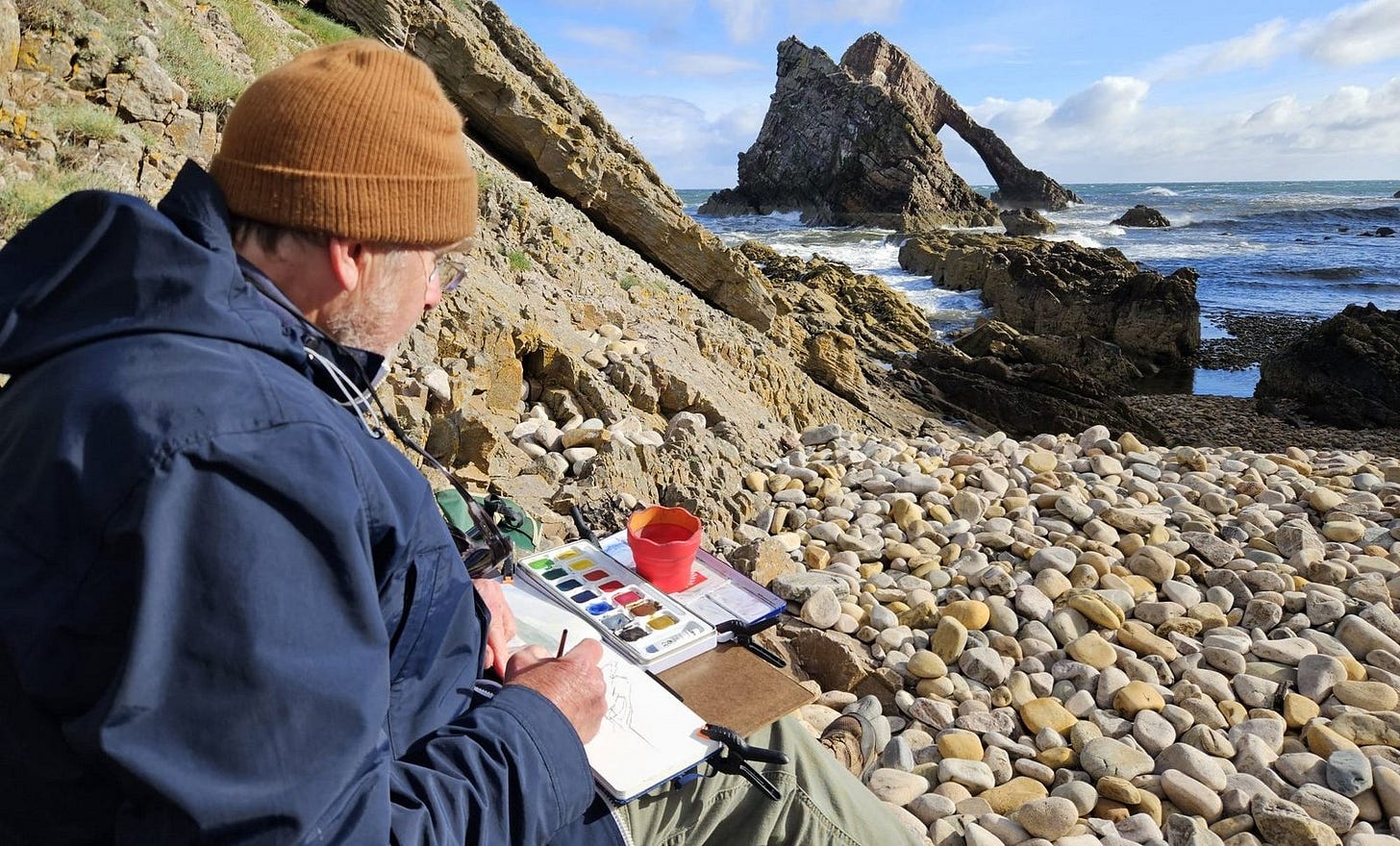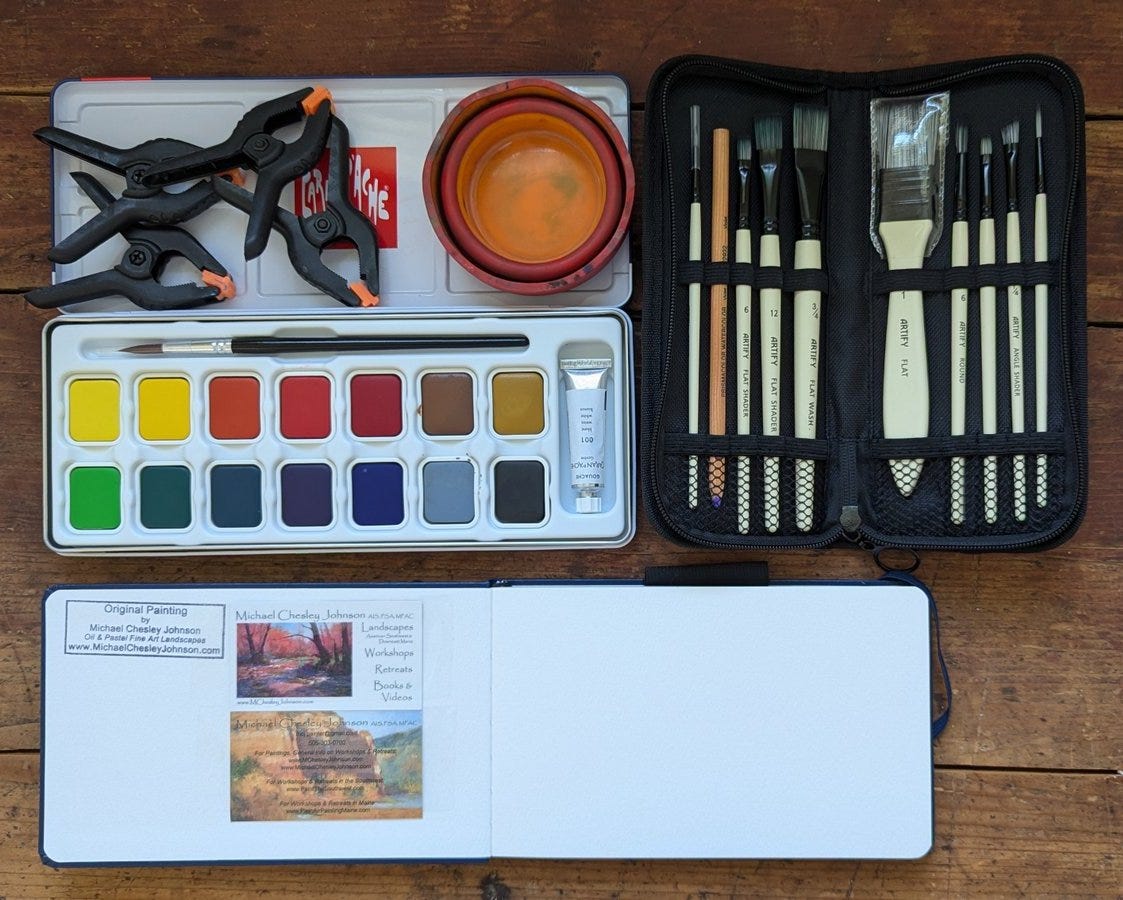Excerpt: Through a Painter's Brush: Scotland / Gear & Materials
Here's a small section of my new book!
[This is a short excerpt from my new book, Through a Painter’s Brush: Scotland, which is available in hardcover, paperback and Kindle editions from Amazon. In this section, I talk about gear and materials.]

I like to fly out of Halifax, Nova Scotia, to Scotland. The airport is a pleasant, six-hour drive from my summer studio on Campobello Island in New Brunswick. Plus, it's only a little over five hours from Halifax to Glasgow or Edinburgh. Usually, for a long visit, I'd check a couple of suitcases. But, because my Scotland trips usually involve lugging bags between modes of transportation, I check only one—or sometimes, none—and try not to pack so much that it’s heavy. All the important stuff—the art gear—goes carry-on if at all possible. (Pastels, especially.) If something ends up being transferred to Timbuktu, I'd rather it be my rain gear and not my painting gear. I figure I can always buy a mackintosh in the closest village, but not so easily the painting materials.

For my first trip, I took my “double-sketchbook” pastel box from Heilman Designs plus a tripod. The pastel box I filled with an assortment of pastels. The foundation was a 50-stick landscape set1 I'd created for Pastels Girault, and since the “double-sketchbook” box is capacious, I filled in the gaps with an assortment of more greens and greys plus a pencil, eraser and sponge brush. I also needed to take oil on this trip, so I packed a basic set of paints and brushes along with a pad of Arches oil paper and sheets of waxed paper to sandwich between the oil sketches. I made the Heilman box do double-duty and used it for oil while leaving all the pastel sticks in.
Because I needed odorless mineral spirits for oil but couldn't fly with them, the only snag on the trip was finding any. (Another solution would be to take water-miscible oils rather than traditional oils.) I did locate some, though. By the way, in Scotland mineral spirits are called “white spirits.” And if you're looking for rubbing alcohol for pastel washes, ask for “surgical spirits.”
For the later trips, I scaled things down more. I didn't even take a tripod. Instead, I took a gardener's foam knee pad to sit on. As thin as it is, it worked surprisingly well, even with my rear planted on the hard rocks of the Quiraing. (An hour's my limit, though.) If I do need to work standing, which might happen if the view requires it, I can usually find a fence post or railing to balance my board on.
Also, as I mentioned, I ultimately decided to sketch only in gouache. Why? My 15-pan gouache kit is very portable. Unlike oil, which requires a solvent that’s sometimes hard to procure, gouache uses only water. Unlike pastel, which consists of some very fragile sticks, the dropping of which would mean heartbreak, the gouache kit in its metal tin is durable. (And no messy paint tubes.) Also, when I took pastel the first time, it was a very limited selection, and I found myself bemoaning the fact that I hadn't brought enough of a variety of greens. I can mix all that variety in gouache. Finally, I didn't fancy myself working in my lap with pastel and getting pastel everywhere. So, you may ask, why not watercolor? I prefer gouache, as it acts much like oil in that it can be variously transparent or opaque and allows for “scumbling” and broken-color—two techniques I enjoy.
Invariably, while on my trip, I was often asked if I was painting in watercolor. When I responded, no, in gouache, I expected puzzlement, but strangely, that wasn't the case. When I started to explain that gouache is a form of opaque watercolor, I got an immediate nod of understanding. “Oh, yes, I can see that now,” said one gentleman as he took a closer look. (And in the UK, it’s pronounced “goo-ASH” not “gwash” like we say here in America.) What’s more, even though gouache is technically opaque, I tend to start off my sketches by thinning it into washes, and the effect is much like a watercolor. I save opaque passages for the very end, and only if necessary.
So here's the full list of what I take for gouache:
Pan gouache: Caran d'Ache Gouache Studio 15 Assorted Colors Set in Metal Tin [Note: Curiously, some of versions of these sets contain a grey, while others do not. Mine has the grey.]
Tube gouache: Holbein Artists' Gouache 40 ml Tube—Permanent White (in case I run out of the 10-ml tube of white that comes with the pan set)
Watercolor journal: Pentalic 5"x8" 140 lb. (300 gsm) AF Aqua Journal 48-page book or similar
Brush set: Jack Richeson Watermedia Pocket Plein Air Brush Set [I’ve also started using a different set from Artify.]
Water container: Faber-Castell “Clic and Go” Portable Water Cup
Watercolor pencil: the color depends on the territory, so for Scotland, I chose a red-violet one that I felt would work well with misty scenes
Four small spring clamps
Backboard: a sheet of MDF for a backboard for supporting journal, tin of gouache pans, water container
Gardener’s foam knee pad

Contact the US distributor for Girault if you are interested in the “Michael Chesley Johnson” landscape set. (I make no money off of it, but it’s a great set!) Email pasteletc@aol.com.




At your suggestion, I purchased a Heilman design double sketchbook for pastel. It just arrived this week and I’m having so much fun, organizing pastels and drawing. Love art gear and learning what other more experienced artists are using.
Thank you, Kathryn